How to Cook Ackee Without Saltfish? 7 Easy Steps!
Cooking ackee without its traditional partner, saltfish, is a versatile process that caters to various dietary needs.
This guide offers step-by-step instructions on selecting and preparing ackee on its own or with non-traditional accompaniments.
Fresh ackee is boiled until soft, then sautéed with a medley of aromatic vegetables and rich seasonings. Alternatives like tofu or beans can be added to create a complete, satisfying meal.
Through this method, the dish remains true to its Jamaican roots while embracing a broader spectrum of flavors.

Key Takeaway
Step 1: Selecting Fresh Ackee
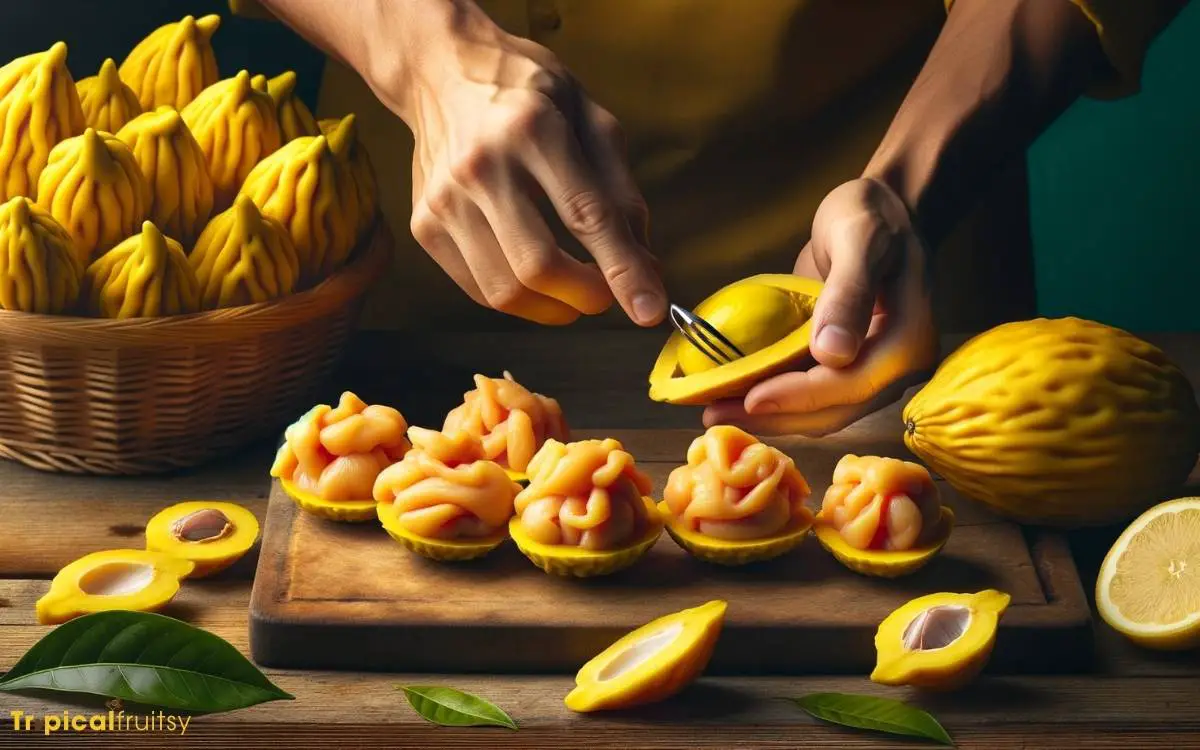
Choosing quality ackee pods is essential for both safety and flavor. The ripeness and firmness of the fruit are important parameters to consider. Ackee, which is the national fruit of Jamaica, must be handled with care due to its toxic nature when unripe.
To ensure that you have selected the best ackee, look for pods that are bright red to orange in color. These pods should naturally open on the tree, indicating that they are ready to be eaten.
When the pods split open, you should see glossy black seeds nestled in soft, yellow arils. These arils are the edible portions of the fruit.
In terms of texture, the fruit should yield slightly under pressure. This indicates that it is perfectly ripe and ready to be enjoyed.
It is important to avoid any ackee pods that are hard or have an unnatural green color. These are indicators of immaturity and can be dangerous to consume.
Once you have chosen the finest ackee pods, the next step is to prepare them with precision and care.
Step 2: Preparing the Ackee
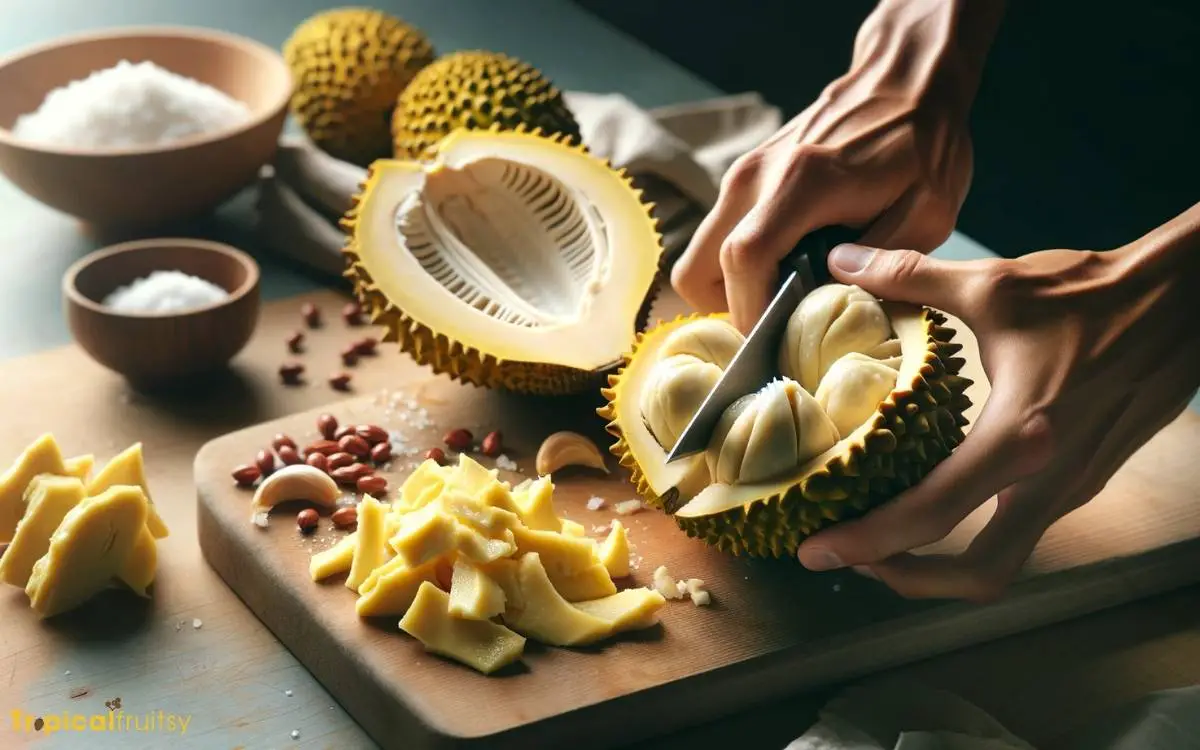
Upon selecting your fresh ackee pods, the first step in preparation is to carefully remove the toxic seeds and the red membrane that encases the edible yellow arils.
It is crucial to ensure that the ackee pods are fully ripe and have naturally opened before you begin this process, as unripe ackee contains harmful toxins.
Gently separate the arils from the pods and discard any traces of the pinkish-red membrane, as it is not safe for consumption. The seeds, which are large and glossy black, should be removed and disposed of with care.
Rinse the yellow arils under cool running water to remove any remaining membrane bits or debris. This meticulous cleaning is essential for a safe and enjoyable ackee dish.
Step 3: Alternative Protein Options
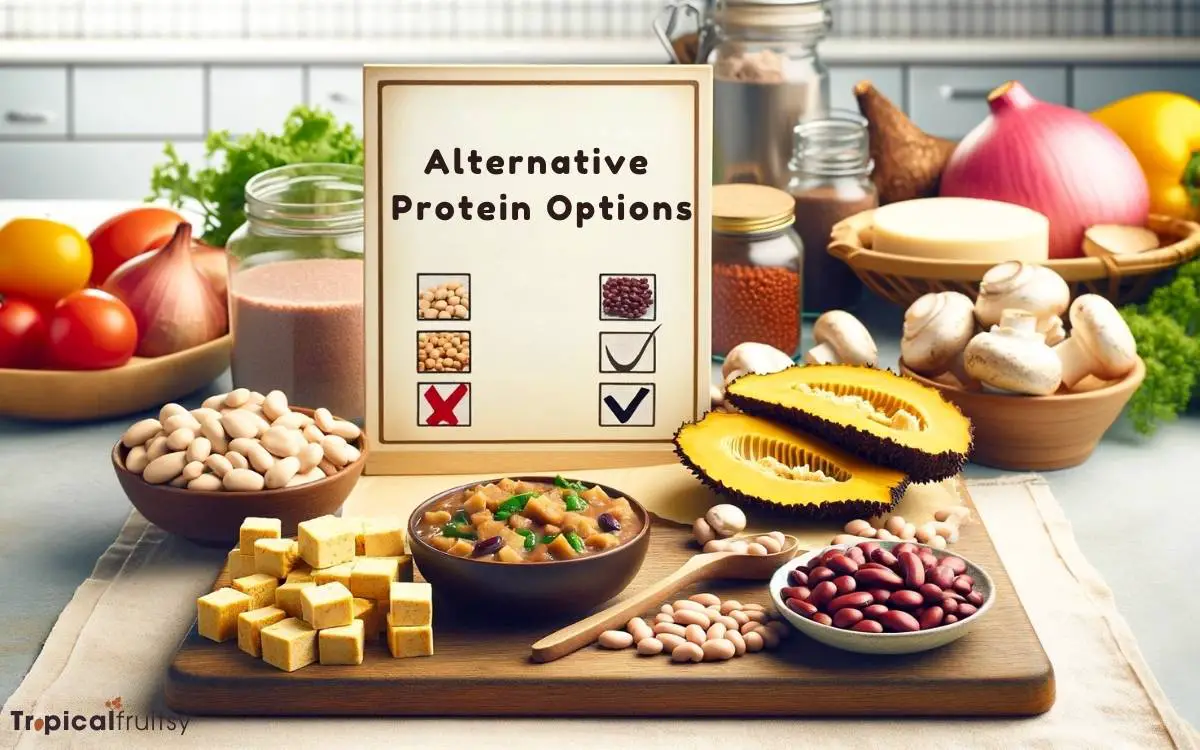
In reimagining the classic Jamaican dish of ackee without its traditional saltfish counterpart, one must consider a variety of alternative protein sources to complement the fruit’s delicate texture and unique flavor.
Plant-based substitutes, such as legumes and tempeh, offer a hearty consistency and can absorb the rich array of spices typically used in Caribbean cuisine.
For those who prefer the ocean’s bounty, a selection of seafood variations or the versatile tofu, with its adeptness for taking on robust flavors, presents a canvas of possibilities for both the novice and experienced cook.
Plant-Based Substitutes
Several plant-based proteins can serve as nutritious substitutes for saltfish in ackee dishes, offering a variety of flavors and textures to complement the fruit’s softness.
These alternatives not only cater to a plant-based diet but also add a unique twist to the traditional Jamaican cuisine.
Indulge in the richness of these options:
Chickpeas (Garbanzo Beans)
- Creamy texture: Melds seamlessly with tender ackee.
- Protein-rich: Satisfies the body’s nutritional needs.
- Versatile flavor: Absorbs herbs and spices beautifully.
Tofu (Firm or Extra-Firm)
- Meaty bite: Provides a satisfying chew.
- Absorbent nature: Ideal for soaking up savory notes.
- Healthful choice: Supports a wholesome lifestyle.
Tempeh
- Nutty essence: Delivers a depth of flavor.
- Grainy consistency: Offers a pleasant contrast.
- Fermented benefits: Encourages a happy gut.
Seafood Variations
For those seeking a taste reminiscent of the ocean without using traditional saltfish, numerous seafood alternatives can infuse your ackee dish with the desired briny flavors.
Consider flaky cod, which offers a subtle sweetness that can complement the buttery texture of ackee.
Smoked haddock also presents a robust option, imparting a distinctive smokiness that elevates the overall dish.
For a firmer texture, chunks of fresh snapper or mahi-mahi can be gently folded into the ackee, providing a meaty bite that stands up to the fruit’s softness.
Scallops or shrimps, lightly sautéed with aromatics before being added to the ackee, offer a delicately tender protein choice that marries well with the mild flavor profile of this Jamaican staple.
Tofu Preparation Techniques
Transitioning from seafood alternatives, tofu emerges as a versatile plant-based substitute that adeptly absorbs the rich flavors accompanying ackee in this classic dish.
When preparing tofu as an alternative protein, there are techniques that enhance its texture and taste, transforming it into a culinary delight that can stir the senses.
Pressing Tofu
- Intensity: Squeeze out excess water for a firmer bite.
- Anticipation: A blank canvas ready to soak up savory spices.
- Satisfaction: Achieving the perfect chewiness that rivals traditional proteins.
Marinating Tofu
- Excitement: Infusing layers of flavor into each porous cube.
- Curiosity: Experimenting with various herbs and seasonings.
- Delight: Reveling in the harmony of flavors that bloom upon cooking.
Cooking Tofu
- Eagerness: Watching it turn golden with a tantalizing crisp.
- Pride: Mastering the art of perfect sear.
- Joy: Sharing a culturally rich meal with a contemporary twist.
Step 4: Sautéing Vegetables

Begin by heating a tablespoon of vegetable oil in a skillet over medium heat to prepare for sautéing the vegetables that will accompany the ackee.
The key to a flavorful vegetable sauté is to ensure that each vegetable is given the right amount of time to cook, preserving its unique texture and color.
This process not only enhances the natural flavors but also ensures a vibrant and eye-appealing addition to the ackee.
| Vegetable | Prep Instructions | Sauté Time |
|---|---|---|
| Bell Peppers | Slice into strips | 3-4 minutes |
| Onions | Dice finely | 2-3 minutes |
| Tomatoes | Chop into cubes | 1-2 minutes |
| Garlic | Mince | 1 minute |
As the vegetables soften and the aromas meld together, you’ll find the dish coming to life, creating a mouthwatering base for the ackee to shine.
Step 5: Seasoning Your Dish
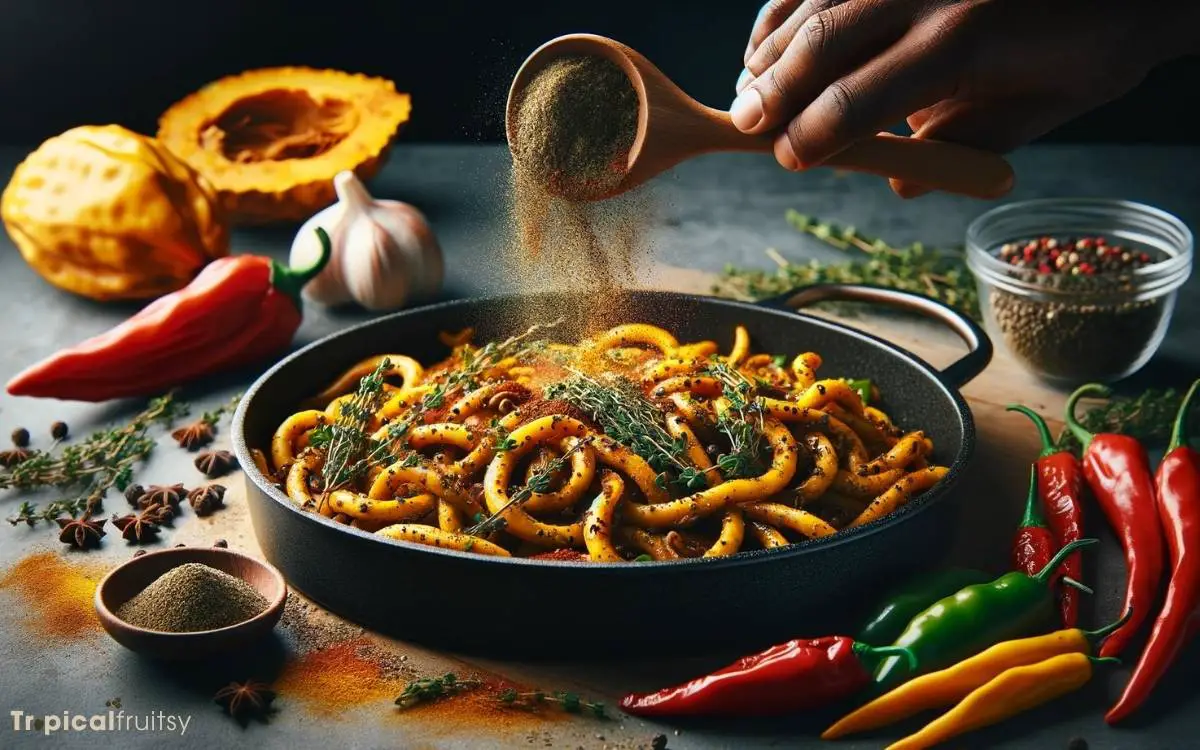
Seasoning is the soul of any dish, and when crafting a flavorful Ackee without Saltfish, the choice of spices and herbs becomes paramount.
Exploring alternative spice blends can introduce an array of flavors that complement the creamy texture of ackee.
Incorporating fresh herbs not only adds a burst of color but also infuses the dish with aromatic depth, elevating it to a culinary delight.
Alternative Spice Blends
Exploring diverse spice blends can elevate the flavor of ackee when preparing it without the traditional saltfish accompaniment.
The right combination of herbs and spices can transform this dish into a sensory delight, bringing new dimensions of taste that satisfy the palate with a symphony of flavors.
Consider these carefully curated alternatives:
Warming Spice Blend:
- Allspice for a cozy, aromatic warmth
- Nutmeg’s sweet spice, which whispers tales of tropical nostalgia
- Cinnamon, to wrap your senses in a comforting, spicy embrace
Herbaceous Medley:
- Thyme, offering an earthy, subtle minty freshness
- Parsley, a burst of mild, yet lively green notes
- Scallion’s bright zing that dances on the tongue
Peppered Zest:
- Black pepper for a sharp, spirited kick
- Paprika, to paint each bite with a smoky, sweet undertone
- Crushed red pepper flakes, igniting a gentle, passionate fire within
Each blend tells its own story, creating a rich tapestry of flavors that ensure ackee remains the star in a salt-free ensemble.
Fresh Herb Usage
Incorporating fresh herbs into your ackee dish often enhances the flavor profile with vibrant, aromatic notes that dried spices cannot fully replicate.
Fresh thyme, often a staple in Caribbean cooking, imparts a subtle, earthy essence, while a sprig of rosemary could introduce a warm, lemon-pine flavor that complements the creamy texture of ackee beautifully.
Chopped scallion, when sautéed, yields a mild, onion-like sweetness, and fresh parsley adds a splash of color along with a clean, slightly peppery taste. To maximize their impact, add these fresh herbs towards the end of the cooking process.
This ensures their delicate flavors and essential oils remain potent, providing your ackee dish with layers of complexity that engage the senses and celebrate the freshness of the ingredients.
Step 6: Cooking and Assembly
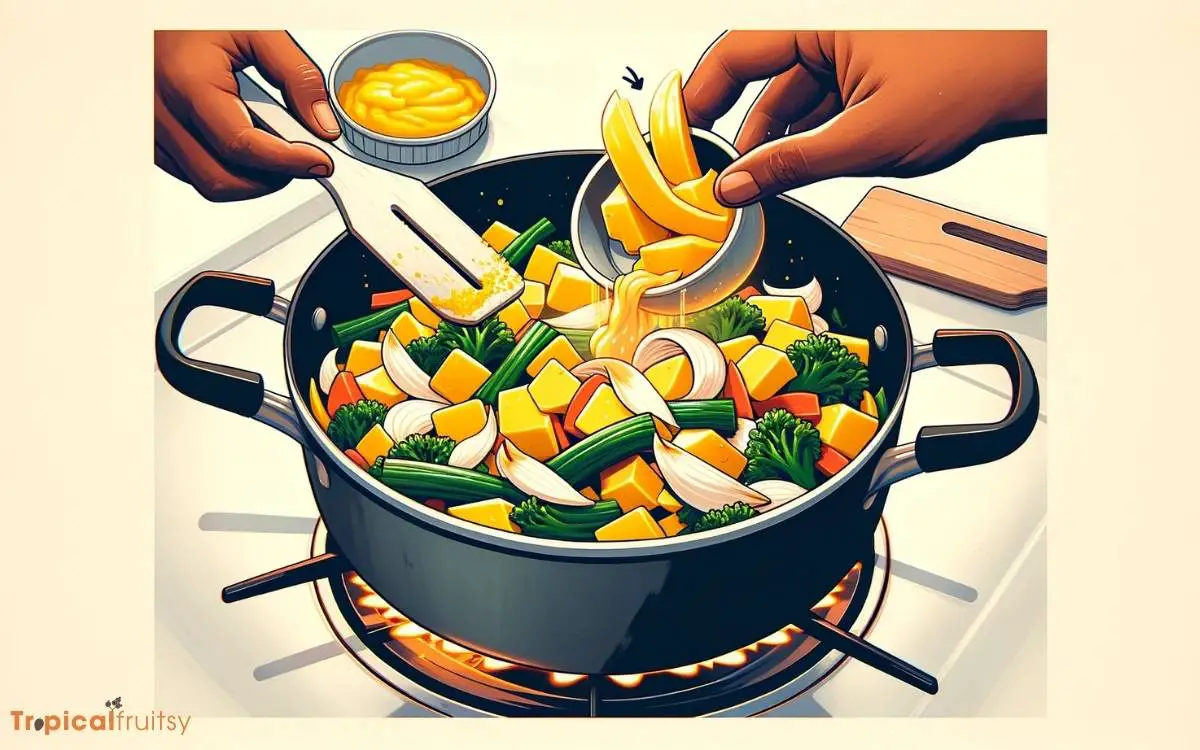
How does one approach the preparation and assembly of ackee when omitting the traditional saltfish component? The key lies in embracing the ackee’s delicate, buttery texture and its ability to marry well with a variety of flavors.
To evoke the rich experience of this dish, consider:
Sautéing:
- Aromatic onions and garlic until translucent
- Bell peppers for a sweet, vibrant note
- Scotch bonnet peppers for a whisper of heat
Simmering:
- Fresh ackee pods gently until just tender
- Tomatoes to add a subtle acidity and richness
Assembling:
- Combining the sautéed vegetables with ackee
- Adjusting seasonings to tailor the dish to your palate
- Garnishing with fresh herbs for a burst of color and flavor
Each step is a brushstroke in this culinary masterpiece, transforming simple ingredients into a soul-satisfying meal.
Can I Use the Same Cooking Method for Ackee Without Saltfish?
Certainly, you can embrace various recipes on how to make ackee dish without the traditional counterpart, saltfish. Opt for sautéing the ackee with aromatic spices and vegetables for a vibrant mix of flavors, or bake with savory herbs for a unique twist on this Jamaican staple.
Step 7: Serving Suggestions
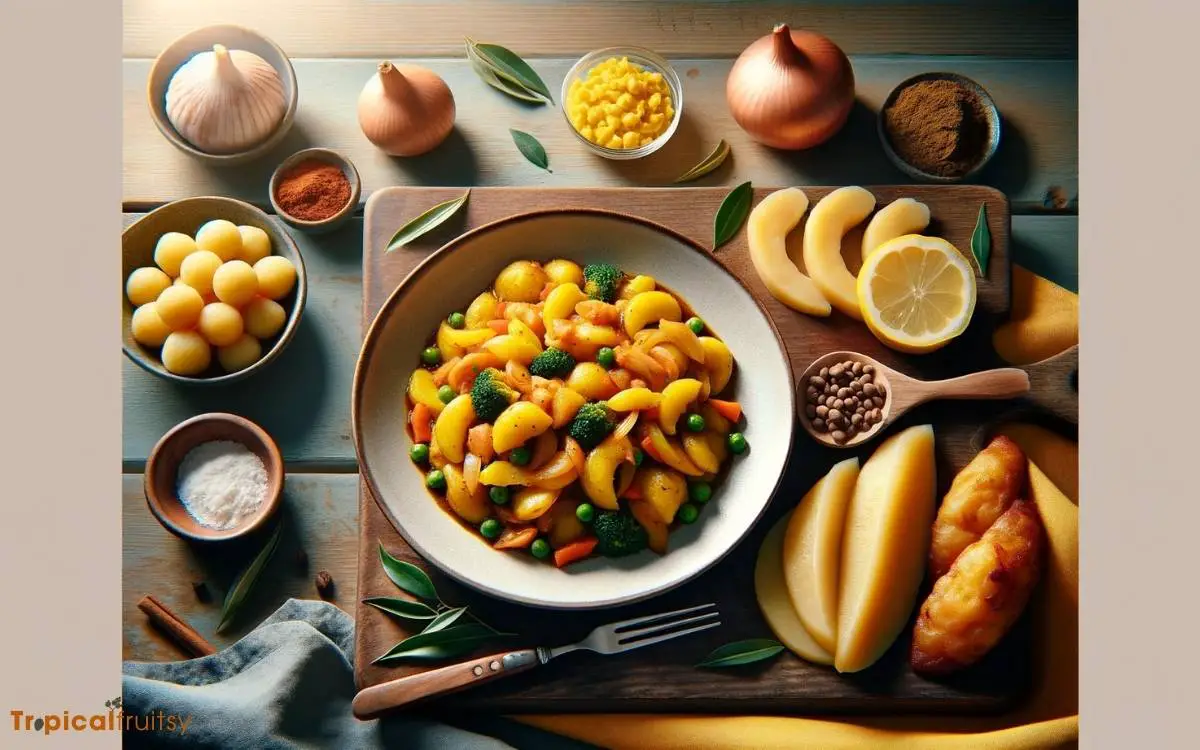
Ackee, when prepared without saltfish, pairs excellently with a variety of side dishes that complement its creamy texture and nuanced flavor profile.
For a wholly satisfying meal, consider serving this Jamaican delicacy with staples such as boiled green bananas, which offer a subtle sweetness and a delightful contrast in texture.
Steamed dumplings or fried dumplings known as ‘johnnycakes’ can also accompany the dish, providing a satisfying chew and a golden, crispy exterior that echoes the subtle richness of the ackee.
For a lighter option, a fresh garden salad dressed with a zesty vinaigrette will balance the ackee’s richness.
Alternatively, roasted breadfruit or sweet potatoes can round out the meal with their earthy sweetness, creating a harmonious plate that is both comforting and nutritionally balanced.
Conclusion
The preparation of ackee without saltfish demonstrates culinary versatility and caters to diverse dietary preferences.
The inclusion of alternative proteins and an array of vegetables enriches the dish with essential nutrients while preserving its cultural significance.
For instance, a Jamaican family opting for a vegetarian lifestyle successfully incorporates tofu as a protein substitute, maintaining traditional flavors with a health-conscious approach, thus exemplifying the adaptability of this iconic Caribbean staple.






